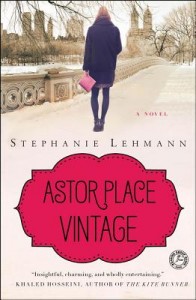Anne Barnhill’s second historical novel, Queen Elizabeth’s Daughter, is set to be released March 18. The indomitable Anne finished this novel and moved on to start work on her next book despite her recent battle with cancer.
And now, I’m happy to say, she’s also managed to contribute another review to Briar Patch Books.
Reviewed by Anne Barnhill
ASTOR PLACE VINTAGE. By Stephanie Lehmann. Touchstone.416 pages. Paperback original. $16.
Astor Place Vintage is a delightful novel set in New York City in 1907 and in 2007.
 Though separated by a century, two women, Olive and Amanda, have more in common that might be expected. Amanda Rosenbloom, the owner of Astor Place Vintage, has a fascination with old clothes, antiques or anything else from times gone by.
Though separated by a century, two women, Olive and Amanda, have more in common that might be expected. Amanda Rosenbloom, the owner of Astor Place Vintage, has a fascination with old clothes, antiques or anything else from times gone by.
When she visits Jane Kelly, a wealthy old woman from whom she hopes to purchase some vintage clothes, she is surprised to find a journal hidden in the lining of an old muff. This journal belongs to Olive Westcott, a young woman who came to New York with her father in 1907.
Unable to stop herself from taking the journal and reading it, Amanda becomes fascinated and embroiled in the details of Olive’s life. Though the two women lived 100 years apart, Amanda finds that the struggles of women trying to make it alone have not changed.
Olive tries to support herself when her wealthy father dies unexpectedly, leaving her without funds; he’d lost everything because of poor investments. Olive wants to be a buyer in a department store and has the polish for such a position. However, she has no verifiable experience; the work she did was for her father and for no pay. Slowly, Olive becomes aware of how hard it is for a young, single woman to survive in New York City. Amanda has a similar experience as she tries to keep her store open in spite of several obstacles.
In alternating chapters, Stephanie Lehmann explores each woman’s challenges.
As an extra treat, she also gives an architectural history of New York City, enriching the novel in the process – the city itself is almost like a character. Her prose is clean and clear:
The journey itself was a diversion. Surrounded by my fellow employees, I had no fear of the subway, as I did that first time.
Or at least not until someone mentioned we were traveling inside a metal tube underneath the East River. I sat prone until we reached Brooklyn, where the train ran aboveground and I could contentedly look out my window at the scenery.
Our route passed endless rows of square brick houses, but the drabness of the dwellings was relieved by the variety of backyards.
The times and places are lovingly described, adding to the grace of the novel. Very nicely done.